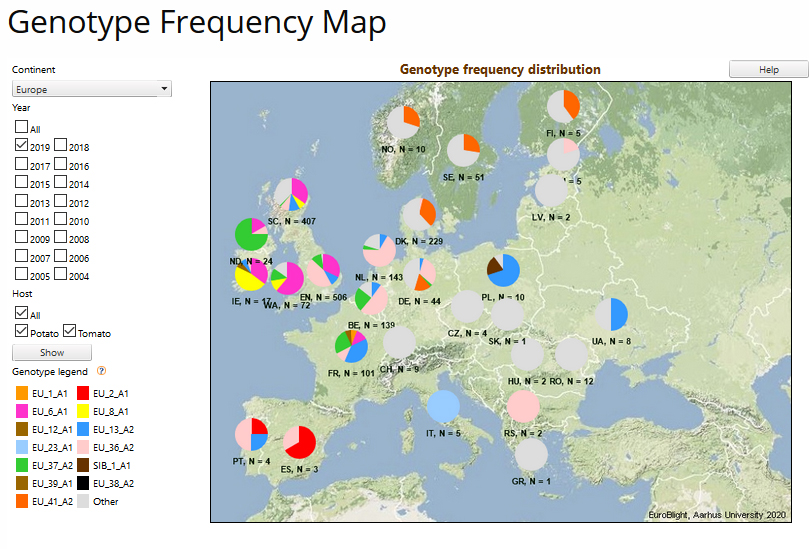Didier Andrivon from INRA directs our thoughts to potato and tomato blights in Europe and argues that multi-actor research is crucial for sustainable control
Blights, that is late blight caused by the oomycete Phytophthora infestans and early blight caused by several Ascomycete species belonging to the genus Alternaria, are a constant source of concern for the European potato and tomato industries. They indeed impose a severe burden on crop yield and quality in both conventional and organic production systems and induce massive control costs and severe environmental pressure.
Controlling blight epidemics have long relied almost exclusively on repeated applications of synthetic fungicides. It is not uncommon for potato crops to receive 15 or 20 sprays a season to keep blights at bay. However, this strategy while efficient, is not sustainable, for three major reasons. First, the pathogens adapt to many of the active ingredients used against them: this is the case for Alternaria strains resistant to both QoI and SDHI fungicides in Europe and North America, and for Phytophthora infestans resistant to phenylamides and more recently, to fluazinam. Second, the number of fungicides families available is constantly decreasing, as a consequence of both pathogen evolution and strict environmental legislation. Third, there is increasing pressure from consumers and society at large to limit or ban altogether pesticides from food products.
The key to sustainable control of blights is, therefore, Integrated Pest Management (IPM), a more complex strategy relying on a combination of control methods, such as prophylaxis (sanitation), resistant cultivars, biocontrol, decision support systems and precision agriculture. IPM has many advantages: it is flexible (each grower can ‘tailor-make’ the strategy that suits local conditions best), it is sustainable (the reliance on multiple components within each strategy is a source of resilience), and it is environmentally-friendly. However, it has also some major issues: it is more difficult to implement and design: it requires efficient surveillance and monitoring of crop status, and it also requires that all actors along the value chain (from agro-industry to consumers and distributors) accept and promote it. Wider adoption of IPM can, thus, only be achieved if all actors take part in its design, implementation and valorisation. This is why multi-actor research and development activities are critically needed.
In the case of potato and tomato blights in Europe, such initiatives can, fortunately, rely on the existence of an active, multi-actor network dedicated to the sustainable control of these problematic diseases: Euroblight. Euroblight is an informal network, to which any individual or organisation engaged in the quest for sustainable control of blights is welcome to participate. It stems from two European concerted actions supported by the European Union (EU) towards the turn of the millennium: EU.NET.ICP (1996-1999), dedicated to the evaluation, development and implementation of Decision Support Systems for improved blight control and Eucablight (1999-2003), concentrating on pathogen evolution and host resistance. The community built during these two projects still forms the core of the current Euroblight network, which continued to meet and act after EU support ended, thanks to self-organisation andsponsorship from potato industry companies.

Euroblight activities and achievements are multiple:
- Collating information is essential for control, especially European pathogen population structures, host behaviour, and harmonised protocols so information can be compared;
- Sharing this information through an ad hoc, evolving IT infrastructure and regular workshops;
- Organising actors, interactions and involvement in research and development activities through collaborative projects;
- Fostering international collaboration;
- Raising attention and advising policymakers about blights and their control.
These activities have been highly successful so far:
- Blights populations and pressure are now surveyed every year in Europe, and the corresponding genetic population structures are made available to everyone through the Euroblight website (Figure 1);
- Unique resources (protocols, software, isolate characteristics, fungicide rating table, etc.) and an open sharing platform accessible through the Website have been developed and are now part of an expanding Potato Late Blight Toolbox;
- The continuous success of Euroblight workshops (17 since 1996), with published Proceedings as well as Statements for policymakers and industry actors – all available directly from the Euroblight homepage;
- Help to the launch and joint operations with ‘sister networks’ in other continents: USABlight in North America, Tizón Liatino in Latin America, AsiaBlight in Asia and an upcoming AfricaBlight;
- Various projects developed from and with the network, including the annual monitoring activities, but also a research project like IPMBlight 2.0 (2016-2019).
These successes stress the value of the multi-actor approach and the flexible organisation of a network like Euroblight to foster efficient, developments and implementation of IPM. To build on these successes, Euroblight will in the future put increased emphasis on biocontrol and alternative control measures, seek stronger involvement of breeders and more active participation of the tomato industry. This will definitely help in keeping potato and tomato blights under control in an uncertain and rapidly changing environment.
*Please note: This is a commercial profile











